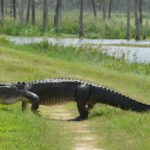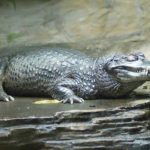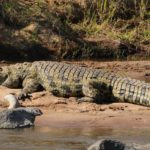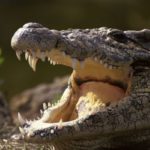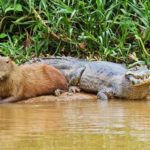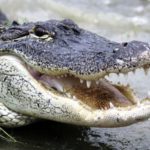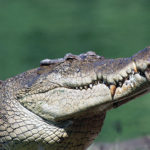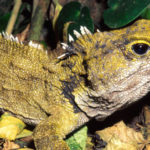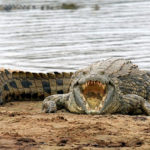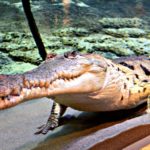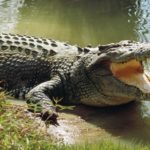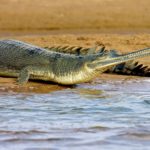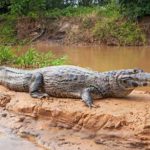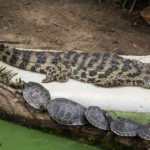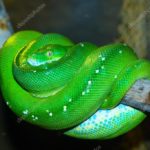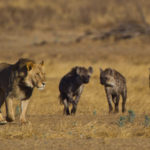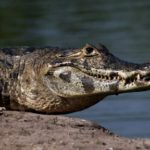Crocodiles
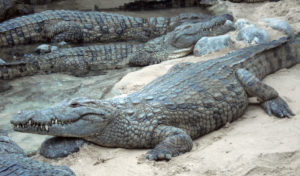 Crocodiles are a peculiar group of reptiles with a specific way of life. In the world there are 22 species of crocodiles that make up a separate detachment. According to the structure of the body, crocodiles are very different from other reptiles and in their origin are closest to dinosaurs. For this in the Reptilian class, they are even singled out as a separate subclass of the Archosaurs (that is, the Ancient Lizardmen).
Crocodiles are a peculiar group of reptiles with a specific way of life. In the world there are 22 species of crocodiles that make up a separate detachment. According to the structure of the body, crocodiles are very different from other reptiles and in their origin are closest to dinosaurs. For this in the Reptilian class, they are even singled out as a separate subclass of the Archosaurs (that is, the Ancient Lizardmen).
Crocodiles are divided into real and alligators (which also include caimans), but outwardly they differ only in that alligators have a muzzle with a wide blunt end, and in crocodiles it is narrowed. The size of different species varies from 1.5 m in length to a blunt crocodile to 10 m in a Nile crocodile. All crocodiles have an elongated, slightly flattened body, a short neck and a large head with a very elongated snout. The crocs of crocodiles are short and are located, like all reptiles, on the sides of the body, and not under the trunk, as in birds and mammals. This arrangement of the extremities leaves an imprint on the mode of movement of crocodiles.
All crocodiles have a long and thick tail. The tail is flattened from the sides and serves as a rudder, motor and thermostat. It is characteristic that the eyes and nostrils are located in the crocodiles on the top of the skull. This allows animals to breathe and see at a time when their body is completely submerged in water. In addition, crocodiles are able to hold their breath and can stay up to 2 hours under water, not floating.
The brain of crocodiles is small, but they are the most reasonable of all reptiles. They also have one more progressive feature. Crocodiles are cold-blooded animals. But it turned out that the crocodiles, straining the muscles of the body, can arbitrarily warm up the blood so that their temperature is 5-7 degrees above the ambient temperature.
The body of crocodiles is covered with thick skin. Instead of small scales covering the body of other reptiles, crocodiles have large scutes. Their shape and size on different parts of the body differ and form a unique pattern. In many species of crocodiles, the scutes are additionally strengthened by the subcutaneous bone plates, which on the head coalesce with the bones of the skull. These plates create a kind of armor, making the body of the crocodile invulnerable to attack from the outside. Coloration of all crocodiles is protective: black, gray, dirty brown. Very rarely come across crocodiles-albinos of white color. In nature, such animals usually do not survive.
Crocodiles are thermophilic animals and live only in the tropics and subtropics. They inhabit almost all parts of the world, except for Antarctica and Europe. All crocodiles are aquatic animals, closely associated with water bodies. The overwhelming majority prefer to settle in small lakes and rivers with a quiet current.
But the crested crocodiles inhabit the marine lagoons and deltas of rivers. These crocodiles, living in Australia and Oceania, often swim wide sea bays and straits between the islands.
Crocodiles are slow, but insidious. Most of the time they spend in stillness, lying in shallow water or passively drifting with the flow. Often crocodiles become so tight that birds and turtles take them for trees and climb them on their backs.
But this tranquility is deceptive: as soon as a potential victim reaches the limits of reach as a crocodile makes a sharp throw. In this important role is played by a powerful tail, the movements of which the crocodile throws out its body forward. The splash of water attracts other crocodiles and they instantly swim to the victim from all around.
Constant stay in cool water reduces body temperature, which means, and the total metabolism. In order not to “freeze” animals are forced to crawl out on land and bask for several hours on the shore. On land, crocodiles are also practically immobile.
On the ground they move crawling, clumsily arranging their legs and wagging the body from side to side. However, sometimes crocodiles can move to a completely “drill” step, keeping their legs under the trunk. In case of extreme danger, the crocodile can even run at a speed of 12 km / h!
Crocodiles feed on any animal food that can be found in the water or on the shore. They mostly eat fish, as well as small animals and birds swimming in the pond. Young crocodiles, unable to attack such game because of the size, are satisfied with hunting for insects, mollusks, frogs. But the largest species of crocodiles prefer not to be trifled: they lie in wait for large animals that came to the watering place – buffalo, zebra, antelope.

